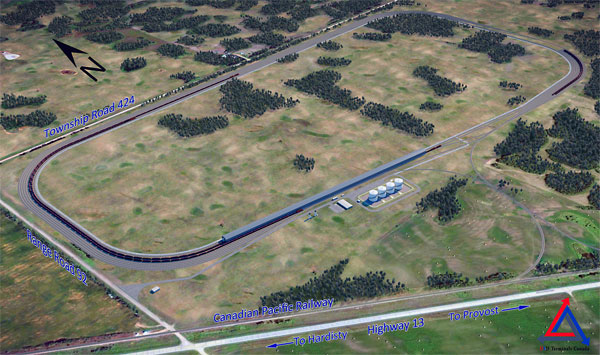Gibsons and USD Terminals Canada discuss new project at open house

Gibsons Energy and USD Terminals Canada (USD Canada) discussed plans for a new rail loading facility and pipeline before around 80 people during a joint open house held Wednesday, Dec. 5 in Hardisty.
The project site is 12km from Hardisty, east of the hamlet of Rosyth, in the M.D. of Provost.
USD will construct a “Y” track that will take CP trains off the main Highway 13 line, and build a loop, along with a covered loading structure designed for loading up to 30 cars at once.
The facility is intended to receive and load full unit trains of up to 120 cars per day.
Janine Ralph, a consultant for the project who took part in the open house, said that the loop design will minimize noise at the site, as it eliminates the need for the trains to back up, which is typically very noisy when the car couplings bang together.
The facility will also have storage parking on site for manifest cars, that is single or usually multiple cars that are not part of a full unit train.
Ralph said that the area in the centre of the loop will still be viable for agricultural development, as well.
Gibson Energy’s part of the project will be the construction of 4.6 km of 20-inch diameter pipeline from their existing terminal near Hardisty to the new loading facility.
In addition, they will bring four 800hp pumps onto their existing site to facilitate the movement of oil to the new facility.
Four 15,000 barrel (bbl) storage tanks, with the appropriate liners and berms, and floating roofs, are also to be built by Gibsons at the facility site, not as storage, Ralph says, but to supplement the flow to the rail loading rack, providing even and constant flow to the cars.
Ralph says that each car can hold between 600 – 700 barrels, depending on the vapour pressure of the product being loaded, giving the facility the capacity of between 140,000 and 172,000 barrels per day.
Train traffic along the Hardisty/Wetaskiwin line is currently around one train every four hours; this project would see that traffic increase to about one train every three hours.
USD has constructed and operated 11 similar facilities in the last decade, and Ralph says they were approached to consider a facility in this area by a number of different parties.
“It’s a great way to move specialty products,” she said, “a supplementary way of moving oil to facilities not close to main pipelines.”
Gibson Energy’s Hardisty Terminal is a sweet crude facility, and information from the open house says that all products transferred to the new terminal will not contain significant amounts of Hydrogen Sulfide.
USD Terminals Canada says they do not anticipate any odours from the project, and will comply will all applicable provincial and federal regulations exceeding requirements where possible, including those specific to air emissions.
After public input, both projects will go through a regulatory approval process, and both companies hope to begin construction mid-2013.
Both parties hope and expect the facility will be operational by 2014, with an expected permanent staff of between 35 and 50 people at the loading facility.







